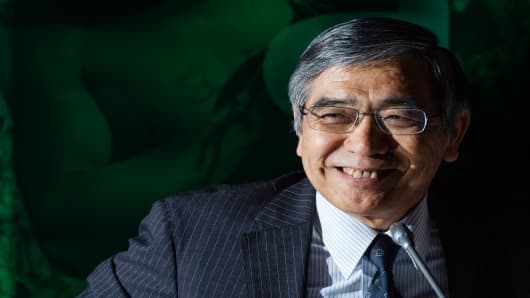The Bank of Japan will not bankroll government spending, but it has already exceeded self-imposed limits on asset purchases and will continue to do so, its new governor said on Thursday in a signal he intended to deliver on promises of overhauling policy.
Haruhiko Kuroda also told lawmakers he was looking at buying longer-dated government bonds to end 15 years of deflation, reinforcing expectations the BOJ's new leadership would use next week's policy meeting to launch its radical easing campaign.
Yields on benchmark 10-year government bonds hit a decade low for the sixth day in a row on Thursday as investors braced for the increased central bank purchases of debt.
(Read More: New BOJ Head Poised to Lead Regime Change)
"Scrapping the BOJ's bank-note rule is an option to consider, but this decision must be taken at the monetary policy committee," Kuroda told lawmakers in the upper house of parliament, a week after taking charge at the central bank.
"We've already broken this rule and asset purchases will exceed bank notes in circulation even more in the future."
The rule limits the BOJ's long-term JGB holdings to the value of bank notes in circulation, and it is seen as a way to prevent both debt purchases from spiraling out of control.
However, the BOJ's asset purchase schemes have become so complex over the years that enforcing the rule is no longer practical, some economists say.
(Read More: Ssshh! Why Japan Is Keeping Quiet on the Yen)
Still, there would be important symbolism in formally abandoning the rule, as the BOJ originally created the limit to avoid giving the impression it was monetizing debt.
Speaking ahead of the April 3-4 policy meeting, Kuroda said the BOJ would seek to bring down market interest rates by buying longer-dated government bonds, largely repeating his message from Tuesday when he addressed the parliament's lower house
Follow Through
The 10-year yield dipped 0.5 basis point to 0.510 percent, its lowest since June 2003, when it hit a record trough of 0.430 percent due to the BOJ's quantitative easing measures.
It has fallen 28.5 basis points so far this quarter, on track for its biggest three-month fall since April-June 2010.
Expectations Kuroda would steer the BOJ toward more aggressive action have also seen investors sell the yen, helping push the dollar up to a 3-1/2 year high of 96.71 yen earlier this month.
(Read More: Weak Yen: Japan Can't Have Cake and Eat It Too)
Kuroda, previously head of the Asian Development Bank, has promised to pursue bolder, unorthodox policies and do "whatever it takes" to end deflation.
Those policies centre on a 2 percent inflation target, which was adopted in January. Kuroda told lawmakers the key to success was to show strong commitment to the target, communicate it clearly to markets and back it up with action.
"We need to follow through on what we say and deliver bold monetary easing so as not to betray market expectations," Kuroda said.
Kuroda has said the inflation goal could be reached in around 2 years, but many doubt it can be achieved that quickly.
People familiar with BOJ thinking told Reuters on Wednesday the central bank was likely to start open-ended asset purchases immediately rather than in 2014 and consider setting a new target to buy longer-dated bonds at next week's meeting.
(Read More: US Shale No Panacea for Japan's Crippling Energy Bills)
They said the central bank was likely to increase the amount of assets it buys and to extend the duration of bonds it targets to five years or even longer, from the current three years.
Under the BOJ's current program, it has pledged to supply 101 trillion yen by the end of 2013 by buying assets and issuing loans, but the debt purchases are limited to maturities of three years or less.
The BOJ also buys 21.6 trillion yen worth of JGBs per year in "rinban" market operations, which can target any duration.


